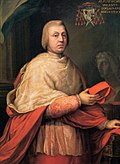History
A very large basilica was built some metres from the present church in the 4th century, to which was attached the large private mausoleum for Constantina, the daughter of Constantine I. The mausoleum was later converted into a church, which survives and is now known as Santa Costanza (she was venerated as a saint, even though she was not one officially). It contains very important 4th century mosaics, especially large areas of ceiling in a secular style, but also two small apse mosaics, one including an early depiction of Jesus in what has become the standard style of long fair hair and a halo.
The large basilica decayed during the decline of Rome, and was replaced in the 7th century by the present much smaller church, commissioned by Pope Honorius I. The lower part of the walls from about half of one side of the Constantinian basilica, and its apse, can still be seen. The new church was over what was believed to be Agnes's grave. The floor level of the 7th-century church is some two metres above the level of the catacomb floor, and the public street entrances are at the level of the 2nd floor gallery. A long wide internal set of steps, lined with inscriptions from the catacombs and other ancient buildings set into the walls, leads down from the street level to the floor level of the church. The apse mosaic from Honorius's time is still present, and less affected by restoration than most mosaics of this date. On a gold ground, a central standing figure of Agnes in the costume of a Byzantine empress is flanked by Honorius, offering a model of the building, and another pope, whose identity is uncertain. The church was also built with a separate upper gallery for women (matronaeum), similar to that of San Lorenzo fuori le mura. Saint Emerentiana was also buried here. [3]
The catacombs are on three levels, dating from the 2nd to the 5th centuries; part of the highest level dating to the 2nd century can be visited by a guided tour. Though no paintings remain in place, there are a number of inscriptions and engraved images of interest. Many more inscriptions line the large staircase leading from the main convent above to the church.
It is in this church that on the feast day of St. Agnes (January 21), two lambs are specially blessed, usually by the pope after a pontifical high Mass; their wool is later woven into pallia, ceremonial neck-stoles sent by the popes to newly elevated Metropolitan-archbishops to symbolise their union with the papacy.
The church was assigned to the Canons Regular of the Lateran by Pope Innocent VIII in 1489; and they continued to serve it after Pope Clement XI made it a parish church in 1708. It is the headquarters of the primaria sodality of the Children of Mary, founded here in 1864. [4]
This page is based on this
Wikipedia article Text is available under the
CC BY-SA 4.0 license; additional terms may apply.
Images, videos and audio are available under their respective licenses.
































